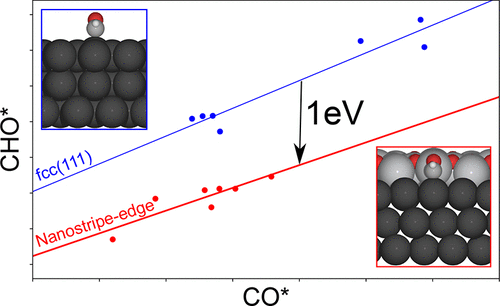当前位置:
X-MOL 学术
›
ACS Catal.
›
论文详情
Our official English website, www.x-mol.net, welcomes your feedback! (Note: you will need to create a separate account there.)
Strongly Modified Scaling of CO Hydrogenation in Metal Supported TiO Nanostripes
ACS Catalysis ( IF 12.9 ) Pub Date : 2018-10-03 00:00:00 , DOI: 10.1021/acscatal.8b03327 Robert B. Sandberg 1 , Martin H. Hansen 2 , Jens K. Nørskov 1, 2, 3 , Frank Abild-Pedersen 2 , Michal Bajdich 2
ACS Catalysis ( IF 12.9 ) Pub Date : 2018-10-03 00:00:00 , DOI: 10.1021/acscatal.8b03327 Robert B. Sandberg 1 , Martin H. Hansen 2 , Jens K. Nørskov 1, 2, 3 , Frank Abild-Pedersen 2 , Michal Bajdich 2
Affiliation

|
The boundary between a metal-oxide and its metal support (metal-oxide|support) provides an intriguing structural interface for heterogeneous catalysis. The hydrogenation of CO is a reaction step believed to be rate limiting in electrochemical CO2 reduction. Density functional theory (DFT) calculations were performed to study this reaction step for a class of catalytic material: metal supported TiO nanostripes. The most stable adsorption sites were identified for all metal supports which showed a striking difference in adsorbate geometry between the strong and weak binding metal supports. The modified CO hydrogenation scaling shows a significant strengthening over (111) and (211) transition metal surfaces. Such enhancement can be attributed to a combination of geometrical effects and metal-oxide|support electronic interactions. A correlation analysis was performed to identify the key features needed to accurately predict *CO and *CHO adsorption energies on the TiO nanostripes and to further validate our physical analysis of the results. This structural motif seems to be a promising avenue to explore scaling modification in other metal-oxide materials and reactions.
中文翻译:

金属负载的TiO纳米带中CO加氢的强改性结垢
金属氧化物及其金属载体(金属氧化物)之间的边界为非均相催化提供了有趣的结构界面。CO的氢化是被认为是电化学CO 2速率限制的反应步骤减少。进行密度泛函理论(DFT)计算以研究一类催化材料:金属负载的TiO纳米带的反应步骤。对于所有金属载体,鉴定出最稳定的吸附位点,它们在强结合金属载体和弱结合金属载体之间显示出明显的吸附物几何形状差异。改进的一氧化碳加氢结垢显示出(111)和(211)过渡金属表面的显着强化。这种增强可以归因于几何效应和金属氧化物电子相互作用的组合。进行了相关分析,以确定准确预测TiO纳米带上* CO和* CHO吸附能并进一步验证结果的物理分析所需的关键特征。
更新日期:2018-10-03
中文翻译:

金属负载的TiO纳米带中CO加氢的强改性结垢
金属氧化物及其金属载体(金属氧化物)之间的边界为非均相催化提供了有趣的结构界面。CO的氢化是被认为是电化学CO 2速率限制的反应步骤减少。进行密度泛函理论(DFT)计算以研究一类催化材料:金属负载的TiO纳米带的反应步骤。对于所有金属载体,鉴定出最稳定的吸附位点,它们在强结合金属载体和弱结合金属载体之间显示出明显的吸附物几何形状差异。改进的一氧化碳加氢结垢显示出(111)和(211)过渡金属表面的显着强化。这种增强可以归因于几何效应和金属氧化物电子相互作用的组合。进行了相关分析,以确定准确预测TiO纳米带上* CO和* CHO吸附能并进一步验证结果的物理分析所需的关键特征。


























 京公网安备 11010802027423号
京公网安备 11010802027423号